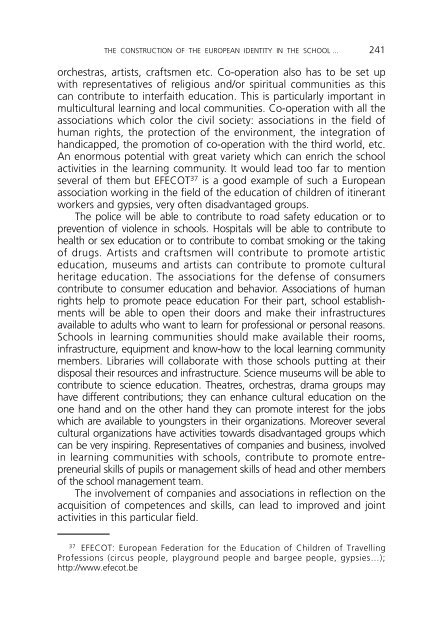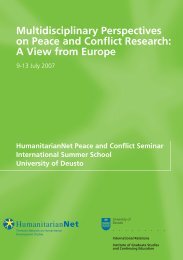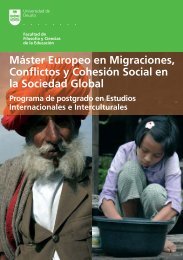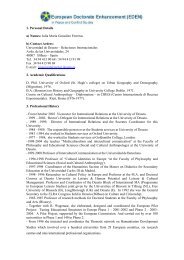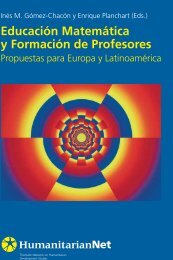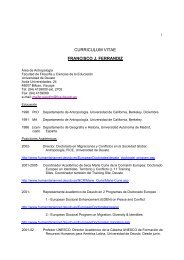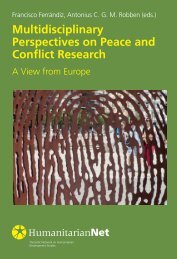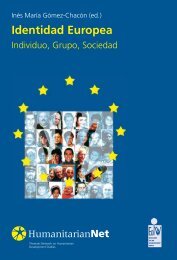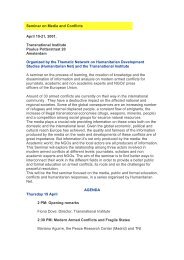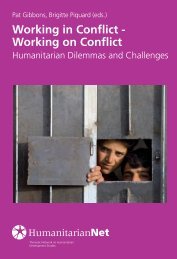- Page 1:
Inés María Gómez-Chacón (ed.)Eu
- Page 5 and 6:
European Identity.Individual, Group
- Page 7 and 8:
ContentsIntroduction . . . . . . .
- Page 9:
CONTENTS 914. The Construction of E
- Page 12 and 13:
12 EUROPEAN IDENTITY. INDIVIDUAL, G
- Page 14 and 15:
14 EUROPEAN IDENTITY. INDIVIDUAL, G
- Page 16 and 17:
16 EUROPEAN IDENTITY. INDIVIDUAL, G
- Page 18 and 19:
18 EUROPEAN IDENTITY. INDIVIDUAL, G
- Page 20 and 21:
20 EUROPEAN IDENTITY. INDIVIDUAL, G
- Page 22 and 23:
22 EUROPEAN IDENTITY. INDIVIDUAL, G
- Page 24 and 25:
24 EUROPEAN IDENTITY. INDIVIDUAL, G
- Page 27 and 28:
Opening AddressCamino Cañón Loyes
- Page 29 and 30:
OPENING ADDRESS 29throughout histor
- Page 31 and 32:
OPENING ADDRESS 31—To gather expe
- Page 33 and 34:
OPENING ADDRESS 33European nature a
- Page 37 and 38:
1.What do we Mean When we Say Europ
- Page 39 and 40:
WHAT WE MEAN WHEN WE SAY EUROPE 39W
- Page 41 and 42:
WHAT WE MEAN WHEN WE SAY EUROPE 41O
- Page 43 and 44:
WHAT WE MEAN WHEN WE SAY EUROPE 43u
- Page 45 and 46:
WHAT WE MEAN WHEN WE SAY EUROPE 45e
- Page 47:
WHAT WE MEAN WHEN WE SAY EUROPE 47A
- Page 50 and 51:
50 EUROPEAN IDENTITY. INDIVIDUAL, G
- Page 52 and 53:
52 EUROPEAN IDENTITY. INDIVIDUAL, G
- Page 54 and 55:
54 EUROPEAN IDENTITY. INDIVIDUAL, G
- Page 56 and 57:
56 EUROPEAN IDENTITY. INDIVIDUAL, G
- Page 58 and 59:
58 EUROPEAN IDENTITY. INDIVIDUAL, G
- Page 60 and 61:
60 EUROPEAN IDENTITY. INDIVIDUAL, G
- Page 62 and 63:
62 EUROPEAN IDENTITY. INDIVIDUAL, G
- Page 64 and 65:
64 EUROPEAN IDENTITY. INDIVIDUAL, G
- Page 66 and 67:
66 EUROPEAN IDENTITY. INDIVIDUAL, G
- Page 69 and 70:
3.Europe, from the Institutional Re
- Page 71 and 72:
EUROPE, FROM THE INSTITUTIONAL REFE
- Page 73 and 74:
EUROPE, FROM THE INSTITUTIONAL REFE
- Page 75 and 76:
EUROPE, FROM THE INSTITUTIONAL REFE
- Page 77 and 78:
EUROPE, FROM THE INSTITUTIONAL REFE
- Page 79 and 80:
EUROPE, FROM THE INSTITUTIONAL REFE
- Page 81 and 82:
EUROPE, FROM THE INSTITUTIONAL REFE
- Page 83 and 84:
4.The European Dimension of Educati
- Page 85 and 86:
THE EUROPEAN DIMENSION OF EDUCATION
- Page 87 and 88:
THE EUROPEAN DIMENSION OF EDUCATION
- Page 89 and 90:
THE EUROPEAN DIMENSION OF EDUCATION
- Page 91 and 92:
THE EUROPEAN DIMENSION OF EDUCATION
- Page 93 and 94:
THE EUROPEAN DIMENSION OF EDUCATION
- Page 95 and 96:
THE EUROPEAN DIMENSION OF EDUCATION
- Page 97:
THE EUROPEAN DIMENSION OF EDUCATION
- Page 100 and 101:
100 EUROPEAN IDENTITY. INDIVIDUAL,
- Page 102 and 103:
102 EUROPEAN IDENTITY. INDIVIDUAL,
- Page 104 and 105:
104 EUROPEAN IDENTITY. INDIVIDUAL,
- Page 106 and 107:
106 EUROPEAN IDENTITY. INDIVIDUAL,
- Page 108 and 109:
108 EUROPEAN IDENTITY. INDIVIDUAL,
- Page 111 and 112:
6.European Programmes from SpainEnc
- Page 113 and 114:
EUROPEAN PROGRAMMES FROM SPAIN 113(
- Page 115 and 116:
EUROPEAN PROGRAMMES FROM SPAIN 115S
- Page 117 and 118:
EUROPEAN PROGRAMMES FROM SPAIN 117s
- Page 119 and 120:
EUROPEAN PROGRAMMES FROM SPAIN 119A
- Page 121 and 122:
7.Is the European Model Being Rejec
- Page 123 and 124:
IS THE EUROPEAN MODEL BEING REJECTE
- Page 125 and 126:
IS THE EUROPEAN MODEL BEING REJECTE
- Page 127 and 128:
8.Boderline Europeans:Nationalisms
- Page 129 and 130:
BODERLINE EUROPEANS: NATIONALISMS A
- Page 131 and 132:
BODERLINE EUROPEANS: NATIONALISMS A
- Page 133 and 134:
BODERLINE EUROPEANS: NATIONALISMS A
- Page 135 and 136:
BODERLINE EUROPEANS: NATIONALISMS A
- Page 137 and 138:
BODERLINE EUROPEANS: NATIONALISMS A
- Page 139 and 140:
BODERLINE EUROPEANS: NATIONALISMS A
- Page 141 and 142:
BODERLINE EUROPEANS: NATIONALISMS A
- Page 143 and 144:
9.Difference as Destabilizing Facto
- Page 145 and 146:
DIFFERENCE AS DESTABILISING FACTOR
- Page 147 and 148:
DIFFERENCE AS DESTABILISING FACTOR
- Page 149 and 150:
DIFFERENCE AS DESTABILISING FACTOR
- Page 151 and 152:
DIFFERENCE AS DESTABILISING FACTOR
- Page 153 and 154:
DIFFERENCE AS DESTABILISING FACTOR
- Page 155:
DIFFERENCE AS DESTABILISING FACTOR
- Page 158 and 159:
158 EUROPEAN IDENTITY. INDIVIDUAL,
- Page 160 and 161:
160 EUROPEAN IDENTITY. INDIVIDUAL,
- Page 162 and 163:
162 EUROPEAN IDENTITY. INDIVIDUAL,
- Page 164 and 165:
164 EUROPEAN IDENTITY. INDIVIDUAL,
- Page 166 and 167:
166 EUROPEAN IDENTITY. INDIVIDUAL,
- Page 168 and 169:
168 EUROPEAN IDENTITY. INDIVIDUAL,
- Page 170 and 171:
170 EUROPEAN IDENTITY. INDIVIDUAL,
- Page 173 and 174:
11.What Makes us European? Identity
- Page 175 and 176:
WHAT MAKES US EUROPEAN? IDENTITY CO
- Page 177 and 178:
WHAT MAKES US EUROPEAN? IDENTITY CO
- Page 179 and 180:
WHAT MAKES US EUROPEAN? IDENTITY CO
- Page 181 and 182:
WHAT MAKES US EUROPEAN? IDENTITY CO
- Page 183 and 184:
WHAT MAKES US EUROPEAN? IDENTITY CO
- Page 185 and 186:
WHAT MAKES US EUROPEAN? IDENTITY CO
- Page 187 and 188:
WHAT MAKES US EUROPEAN? IDENTITY CO
- Page 189 and 190: WHAT MAKES US EUROPEAN? IDENTITY CO
- Page 191 and 192: 12.The Meaning of European Identity
- Page 193 and 194: THE MEANING OF EUROPEAN IDENTITY: P
- Page 195 and 196: THE MEANING OF EUROPEAN IDENTITY: P
- Page 197 and 198: THE MEANING OF EUROPEAN IDENTITY: P
- Page 199 and 200: THE MEANING OF EUROPEAN IDENTITY: P
- Page 201 and 202: THE MEANING OF EUROPEAN IDENTITY: P
- Page 203: THE MEANING OF EUROPEAN IDENTITY: P
- Page 206 and 207: 206 EUROPEAN IDENTITY. INDIVIDUAL,
- Page 208 and 209: 208 EUROPEAN IDENTITY. INDIVIDUAL,
- Page 210 and 211: 210 EUROPEAN IDENTITY. INDIVIDUAL,
- Page 212 and 213: 212 EUROPEAN IDENTITY. INDIVIDUAL,
- Page 214 and 215: 214 EUROPEAN IDENTITY. INDIVIDUAL,
- Page 216 and 217: 216 EUROPEAN IDENTITY. INDIVIDUAL,
- Page 218 and 219: 218 EUROPEAN IDENTITY. INDIVIDUAL,
- Page 220 and 221: 220 EUROPEAN IDENTITY. INDIVIDUAL,
- Page 223 and 224: 14.The Construction of the European
- Page 225 and 226: THE CONSTRUCTION OF THE EUROPEAN ID
- Page 227 and 228: THE CONSTRUCTION OF THE EUROPEAN ID
- Page 229 and 230: THE CONSTRUCTION OF THE EUROPEAN ID
- Page 231 and 232: THE CONSTRUCTION OF THE EUROPEAN ID
- Page 233 and 234: THE CONSTRUCTION OF THE EUROPEAN ID
- Page 235 and 236: THE CONSTRUCTION OF THE EUROPEAN ID
- Page 237 and 238: THE CONSTRUCTION OF THE EUROPEAN ID
- Page 239: THE CONSTRUCTION OF THE EUROPEAN ID
- Page 243 and 244: THE CONSTRUCTION OF THE EUROPEAN ID
- Page 245 and 246: THE CONSTRUCTION OF THE EUROPEAN ID
- Page 247: ConclusionTHE CONSTRUCTION OF THE E
- Page 250 and 251: 250 EUROPEAN IDENTITY. INDIVIDUAL,
- Page 252 and 253: 252 EUROPEAN IDENTITY. INDIVIDUAL,
- Page 255 and 256: 16.Images of Europe: the Perspectiv
- Page 257 and 258: IMAGES OF EUROPE: THE PERSPECTIVE O
- Page 259 and 260: IMAGES OF EUROPE: THE PERSPECTIVE O
- Page 261 and 262: IMAGES OF EUROPE: THE PERSPECTIVE O
- Page 263 and 264: IMAGES OF EUROPE: THE PERSPECTIVE O
- Page 265 and 266: IMAGES OF EUROPE: THE PERSPECTIVE O
- Page 267 and 268: IMAGES OF EUROPE: THE PERSPECTIVE O
- Page 269: IMAGES OF EUROPE: THE PERSPECTIVE O
- Page 272 and 273: 272 EUROPEAN IDENTITY. INDIVIDUAL,
- Page 274 and 275: 274 EUROPEAN IDENTITY. INDIVIDUAL,
- Page 276 and 277: 276 EUROPEAN IDENTITY. INDIVIDUAL,
- Page 278 and 279: 278 EUROPEAN IDENTITY. INDIVIDUAL,
- Page 280 and 281: 280 EUROPEAN IDENTITY. INDIVIDUAL,
- Page 282 and 283: 282 EUROPEAN IDENTITY. INDIVIDUAL,
- Page 284 and 285: 284 EUROPEAN IDENTITY. INDIVIDUAL,
- Page 286 and 287: 286 EUROPEAN IDENTITY. INDIVIDUAL,
- Page 288 and 289: 288 EUROPEAN IDENTITY. INDIVIDUAL,
- Page 290 and 291:
290 EUROPEAN IDENTITY. INDIVIDUAL,
- Page 292 and 293:
292 EUROPEAN IDENTITY. INDIVIDUAL,
- Page 294 and 295:
294 EUROPEAN IDENTITY. INDIVIDUAL,
- Page 296 and 297:
296 EUROPEAN IDENTITY. INDIVIDUAL,
- Page 298 and 299:
298 EUROPEAN IDENTITY. INDIVIDUAL,
- Page 300 and 301:
300 EUROPEAN IDENTITY. INDIVIDUAL,
- Page 302 and 303:
302 EUROPEAN IDENTITY. INDIVIDUAL,
- Page 304 and 305:
304 EUROPEAN IDENTITY. INDIVIDUAL,
- Page 306 and 307:
306 EUROPEAN IDENTITY. INDIVIDUAL,
- Page 308 and 309:
308 EUROPEAN IDENTITY. INDIVIDUAL,
- Page 310 and 311:
310 EUROPEAN IDENTITY. INDIVIDUAL,
- Page 312 and 313:
312 EUROPEAN IDENTITY. INDIVIDUAL,
- Page 314 and 315:
314 EUROPEAN IDENTITY. INDIVIDUAL,
- Page 316 and 317:
316 EUROPEAN IDENTITY. INDIVIDUAL,
- Page 318 and 319:
318 EUROPEAN IDENTITY. INDIVIDUAL,
- Page 320 and 321:
320 EUROPEAN IDENTITY. INDIVIDUAL,
- Page 322 and 323:
322 EUROPEAN IDENTITY. INDIVIDUAL,
- Page 324 and 325:
324 EUROPEAN IDENTITY. INDIVIDUAL,
- Page 327 and 328:
22.The Construction of European Ide
- Page 329 and 330:
THE CONSTRUCTION OF EUROPEAN IDENTI
- Page 331 and 332:
THE CONSTRUCTION OF EUROPEAN IDENTI
- Page 333 and 334:
THE CONSTRUCTION OF EUROPEAN IDENTI
- Page 335 and 336:
THE CONSTRUCTION OF EUROPEAN IDENTI
- Page 337 and 338:
THE CONSTRUCTION OF EUROPEAN IDENTI


